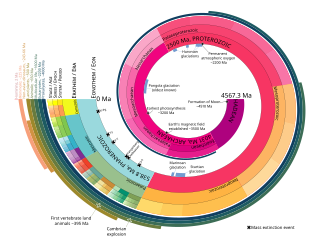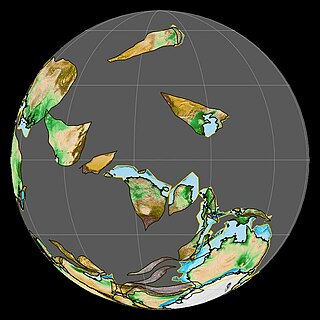Education
| | This section is empty. You can help by adding to it. (November 2022) |
Felix M. Gradstein | |
|---|---|
| Born | 1941 The Netherlands |
| Citizenship | Canada |
| Alma mater | Utrecht University |
| Occupation(s) | Academic; scientist |
| Awards |
|
| Scientific career | |
| Fields | Quantitative stratigraphy Geologic time scale Micropaleontology |
| Institutions | Geological Survey of Canada Dalhousie University Oslo University Portsmouth University |
| Doctoral advisors | Cor Drooger |
Felix M. Gradstein (born 1941, in the Netherlands) is a Dutch-Canadian academic and a pioneer in quantitative stratigraphy and geologic time scale. At the University of Utrecht, he studied paleontology and stratigraphy, obtaining his Ph.D. taking a novel biometrical approach in micropaleontology, [1] under the supervision of Professor CW Drooger. In 1976, after working two years for an oil company in Calgary, Canada, he joined the Geological Survey of Canada in its eastern division at the Bedford Institute of Oceanography in Nova Scotia. During his research there, he was instrumental in developing a novel quantitative method for the analysis of stratigraphic events. In 1992 Felix moved to Norway where he currently has an office at the University of Oslo and is visiting research fellow at University of Portsmouth, UK. From 1985 - 1989, he was chairman of International Geoscience Project (IGCP) 181 on Quantitative Stratigraphy. From 2000 to 2008 he was chair of the International Commission on Stratigraphy (ICS) and in 2010 was instrumental in founding the Geologic Time Scale Foundation. For his fundamental work concerning the Geologic Time Scale, geochronology in general, quantitative stratigraphy, and micropaleontology, the European Geosciences Union awarded him in 2010 the Jean Baptiste Lamarck Medal. Prof. Gradstein, a world-renowned stratigrapher discussed debates over the Geologic Time Scale with the Anthropocene working Group. [2]
As a micropaleontologist and marine stratigrapher Felix also was an active participant in expeditions of the Deep Sea Drilling Project (DSDP) and International Ocean Drilling Project (IODP). As a co-chief scientist in 1980 on DSDP Leg 76 in the Blake Bahama Basin the age of the Atlantic Ocean (~ 165 Ma) was discovered. [3]
| | This section is empty. You can help by adding to it. (November 2022) |

The geologic time scale or geological time scale (GTS) is a representation of time based on the rock record of Earth. It is a system of chronological dating that uses chronostratigraphy and geochronology. It is used primarily by Earth scientists to describe the timing and relationships of events in geologic history. The time scale has been developed through the study of rock layers and the observation of their relationships and identifying features such as lithologies, paleomagnetic properties, and fossils. The definition of standardised international units of geological time is the responsibility of the International Commission on Stratigraphy (ICS), a constituent body of the International Union of Geological Sciences (IUGS), whose primary objective is to precisely define global chronostratigraphic units of the International Chronostratigraphic Chart (ICC) that are used to define divisions of geological time. The chronostratigraphic divisions are in turn used to define geochronologic units.

The Rhyacian Period is the second geologic period in the Paleoproterozoic Era and lasted from 2300 Mya to 2050 Mya. Instead of being based on stratigraphy, these dates are defined chronometrically.

The Zanclean is the lowest stage or earliest age on the geologic time scale of the Pliocene. It spans the time between 5.332 ± 0.005 Ma and 3.6 ± 0.005 Ma. It is preceded by the Messinian Age of the Miocene Epoch, and followed by the Piacenzian Age.
The Toarcian is, in the ICS' geologic timescale, an age and stage in the Early or Lower Jurassic. It spans the time between 184.2 Ma and 174.7 ±0.8 Ma. It follows the Pliensbachian and is followed by the Aalenian.
The Piacenzian is in the international geologic time scale the upper stage or latest age of the Pliocene. It spans the time between 3.6 ± 0.005 Ma and 2.58 Ma. The Piacenzian is after the Zanclean and is followed by the Gelasian.
The Aquitanian is, in the International Commission on Stratigraphy's (ICS) geologic timescale, the oldest age or lowest stage in the Miocene. It spans the time between 23.03 Ma and 20.44 Ma during the Early Miocene. It was a dry, cooling period. The Aquitanian succeeds the Chattian and precedes the Burdigalian.
In the geologic timescale, the Callovian is an age and stage in the Middle Jurassic, lasting between 165.3 ± 1.1 Ma and 161.5 ± 1.0 Ma. It is the last stage of the Middle Jurassic, following the Bathonian and preceding the Oxfordian.
The Campanian is the fifth of six ages of the Late Cretaceous epoch on the geologic timescale of the International Commission on Stratigraphy (ICS). In chronostratigraphy, it is the fifth of six stages in the Upper Cretaceous Series. Campanian spans the time from 83.6 to 72.1 million years ago. It is preceded by the Santonian and it is followed by the Maastrichtian.
The Hettangian is the earliest age and lowest stage of the Jurassic Period of the geologic timescale. It spans the time between 201.3 ± 0.2 Ma and 199.3 ± 0.3 Ma. The Hettangian follows the Rhaetian and is followed by the Sinemurian.
In the geologic timescale, the Kimmeridgian is an age in the Late Jurassic Epoch and a stage in the Upper Jurassic Series. It spans the time between 154.8 ±0.8 Ma and 149.2 ±0.7 Ma. The Kimmeridgian follows the Oxfordian and precedes the Tithonian.
The Famennian is the later of two faunal stages in the Late Devonian epoch. The most recent estimate for its duration is that it lasted from around 371.1 to 359.3 million years ago. An earlier 2012 estimate, still used by the International Commission on Stratigraphy, is that it lasted from 372.15 million years ago to 358.86 million years ago. It was preceded by the Frasnian stage and followed by the Tournaisian stage.

The Serpukhovian is in the ICS geologic timescale the uppermost stage or youngest age of the Mississippian, the lower subsystem of the Carboniferous. The Serpukhovian age lasted from 330.3 Ma to 323.4 Ma. It is preceded by the Visean and is followed by the Bashkirian. The Serpukhovian correlates with the lower part of the Namurian Stage of European stratigraphy and the middle and upper parts of the Chesterian Stage of North American stratigraphy.
The Kasimovian is a geochronologic age or chronostratigraphic stage in the ICS geologic timescale. It is the third stage in the Pennsylvanian, lasting from 307 to 303.7 Ma. The Kasimovian Stage follows the Moscovian and is followed by the Gzhelian. The Kasimovian saw an extinction event which occurred around 305 mya, referred to as the Carboniferous Rainforest Collapse. It roughly corresponds to the Missourian in North American geochronology and the Stephanian in western European geochronology.
In paleontology, biochronology is the correlation in time of biological events using fossils. In its strict sense, it refers to the use of assemblages of fossils that are not tied to stratigraphic sections. Collections of land mammal ages have been defined for every continent except Antarctica, and most are correlated with each other indirectly through known evolutionary lineages. A combination of argon–argon dating and magnetic stratigraphy allows a direct temporal comparison of terrestrial events with climate variations and mass extinctions.

In geology, a group is a lithostratigraphic unit consisting of a series of related formations that have been classified together to form a group. Formations are the fundamental unit of stratigraphy. Groups may sometimes be combined into supergroups.
Geochronometry is a branch of stratigraphy aimed at the quantitative measurement of geologic time. It is considered a branch of geochronology.
The Namurian is a stage in the regional stratigraphy of northwest Europe, with an age between roughly 331 and 319 Ma. It is a subdivision of the Carboniferous system or period, as well as the regional Silesian series. The Namurian is named for the Belgian city and province of Namur where strata of this age occur. The Millstone Grit Group in the lithostratigraphy of northern England and parts of Wales is also of Namurian age.
The Stephanian is a stage in the regional stratigraphy of northwest Europe with an age between roughly 307.5 and 299 Ma. It is a subdivision of the Carboniferous system or period and the regional Silesian series. The uppermost units of the Coal Measures of England and Wales are probably of Stephanian age, though the larger part of this formation is referred to the earlier Westphalian. The stage derives its name from the city of Saint-Étienne for its coal mining basin in eastern central France where strata of this age occur.
Globigerinoides is an extant genus of shallow-water planktonic foraminifera of family Globigerinidae. First appearing in the Oligocene these foraminifera are found in all modern oceans. Species of this genus occupy the euphotic zone, generally at depths between 10-50m, in waters which cover a range of salinities and temperatures. They are a shorter lived species, especially when compared to Globorotalia genus. As a genus Globigerinoides is widely used in various fields of research including biostratigraphy, isotope geochemistry, biogeochemistry, climatology, and oceanography.

Frederik Pieter Agterberg is a Dutch-born Canadian mathematical geologist who served at the Geological Survey of Canada. He attended Utrecht University in The Netherlands from 1954 to 1961. He was instrumental in establishing International Association for Mathematical Geosciences. He received William Christian Krumbein Medal in 1978 from International Association for Mathematical Geosciences. In 1981 Agterberg became a correspondent of the Royal Netherlands Academy of Arts and Sciences. In 2004, he was named IAMG Distinguished Lecturer. He was the president of International Association for Mathematical Geosciences from 2004 to 2008. His contribution in Quantitative Stratigraphy in collaboration with Felix M. Gradstein is noteworthy.